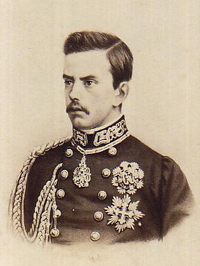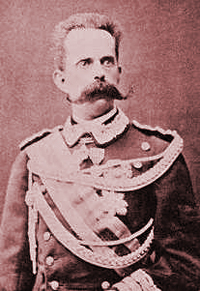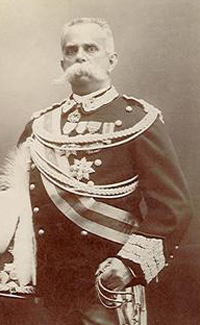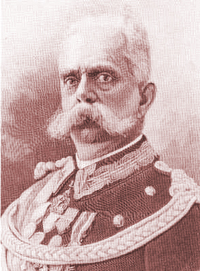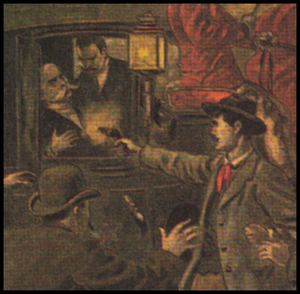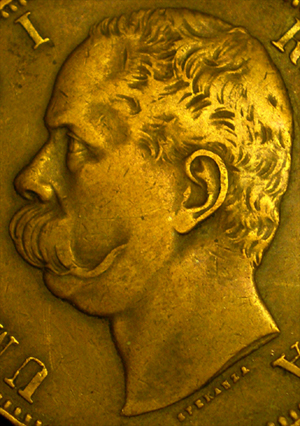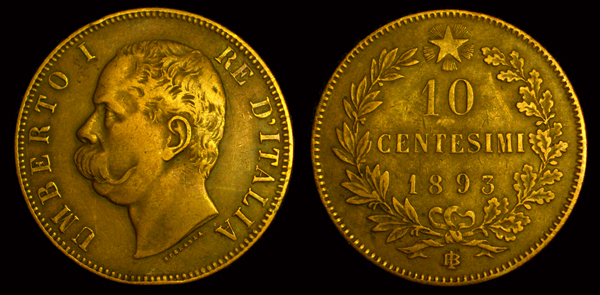
10 CENTESIMI COIN - ITALY - KING UMBERTO I
(KM 27)
- Birmingham Mint
Date: A.D. 1893
Obverse: Portrait head left - UMBERTO I RE D'ITALIA SPERANZA
Reverse: Wreath of laurel and oak with star - 10 CENTESIMI 1893 BI
Engraver: Filippo Speranza
Conte di Cavour, Prime Minister and loyal advisor to the king. |
Umberto Ranieri Carlo Emanuele Giovanni Maria Ferdinando Eugenio di Savoy was born on March 14, 1844 at Turin, in the Kingdom of Sardinia. He was the eldest son of Vittorio Emanuele II of the House of Savoy and his wife Maria Adelaide. As a child he was tutored by statesmen and scholars as his father, through war, strategic alliances, and the efforts of his able prime minister Count de Cavour, pushed to unify Italy. By the age of fifteen he was a Captain serving in the Sardinian army at the Battle of Solferino where French and Sardinian forces defeated Austria. The resulting armistice united many of the Italian states with Sardinia. By 1861 his father had been crowned the first king of a not yet completely united Italy. By 1866 Umberto was in command of a Division when Italy and its allies again went to war with Austria. The result of this war meant more Italian states would unite with his fathers new Italian kingdom. Umberto married Princes Margherita of Savoy in 1868. As the daughter of Ferdinand, the Duke of Genoa, she was his cousin. She bore him his only son and heir, Vittorio Emanuele III, on November 11, 1869. War between France and Prussia would deliver the final pieces needed to complete his fathers unification of Italy. Napoleon III had been a close ally to his father. Without the support of the powerful French Emperor, the formation of the new Italian Kingdom would not have been possible. Relations between the King and Emperor soured when Napoleon denied Emanuele the jewel in his crown, the city of Rome. Napoleon protected the Pope who vigorously opposed Emanuel's goal of a united Italian Kingdom. He kept a force in Rome to aid in its defense but French forces did not fare well against Prussia and Napoleon was forced to recall his troops from Rome. Instead of sending much needed support to the French Emperor, Emanuele II instead took this opportunity to march on Rome and the remaining papal states in 1870. The next year Napoleon III was defeated and Rome was declared capital of a unified Italy. His father spent his last years looking to make peace with Italy's enemies and strengthening diplomatic ties while facing opposition in the form of Socialists, Anarchists, growing anti-royal sentiment and general social upheaval. Umberto inherited these problems when he ascended the throne on the death of Emanuele II in 1878. Later that year, while on tour of the kingdom, he was attacked by an anarchist assassin by the name of Giovanni Passannante. He defended himself with his saber after the would-be assassin tried to stab him during a parade held in Naples. Giovanni Passannante was sentenced to death for his crime but the new king commuted the sentence to life in prison. Queen Margherita was extremely shaken by the violence towards her husband while Umberto saw it as an inevitability of the job. Like his father before him, Umberto was a product of the ridged military upbringing of his house. A well respected and able veteran military commander he faced civil unrest in much the same way he would face an Austrian infantry advance, with military force. Although he accepted the constitutional monarchy, he often acted with absolute authority. A hard-line conservative with a tendency toward authoritarian and imperialist policy, he was loathed by the growing number of leftists, socialists, republicans, and anarchists within his kingdom. Umberto made peace with Austria by joining the Triple Alliance in 1882. Forming an alliance with Austria was unpopular to many Italians. Historically Austria was an enemy to Italy and Italian-majority districts in Trentino and Istria were still Austrian possessions and seen as Italia irredenta ("unredeemed Italy") Although not a popular move, an alliance with Austria and Germany brought further legitimacy, safe borders, powerful allies, and a modicum of stability to the new kingdom in its foreign affairs. It also freed Italy to further its imperial aspirations in Africa. Such aspirations would be severely hampered by lack of popular support at home and the disastrous defeat at the Battle of Adwa in march of 1896. Seeking to join its two African territories, Eritrea and Somalia, Italy attacked one of the few remaining independant African nations, the Ethiopian Empire. What would be called the First Italo–Ethiopian War ended near the town of Adwa where Italian forces were soundly defeated by forces under Ethiopian Emperor Menelik II. Italy signed the Treaty of Addis Ababa, recognizing Ethiopia as an independent state. Growing discontent and social unrest led to large demonstrations. Such unrest was not just in Italy but had been spreading for some time all over Europe. Umberto like many other sovereigns chose to answer this political and social unrest harshly. More often than not he would answer calls for more freedom by curtailing them, answer calls for more by allowing less. There was another attempt on his life in 1897. An unemployed ironsmith from Rome by the name of Pietro Acciarito tried, but failed, to stab the King. The King escaped with his life and the anarchist assassin was given life in prison for his crime. During demonstrations over the rising price of bread, the city of Milan was put under Marshall law. On May 7, 1898, General Fiorenzo Bava-Beccaris fired Cannons into the crowds killing hundreds, at least a thousand more were wounded. The act was generally considered harsh and excessive by the populace. Umberto praised General Bava-Beccaris on the restoration of order. These actions would set off a deadly chain of events. An Italian-American Anarchist, a weaver by trade, by the name of Gaetano Bresci lost his sister to the cannons of General Bava-Beccaris. Upon hearing the Kings praise for the generals actions, Bresci became determined to travel to Italy and kill the king. This he did while the king was visiting the city of Monza. On the evening of July 29, 1900, he shot Umberto several times with a revolver killing him. Bresci was captured and put on trial for murder. He was sentenced to penal servitude for life but was found dead in prison less than a year later. Umberto I served as King of Italy for 22 years and was succeeded by his son Emanuele III.
|

